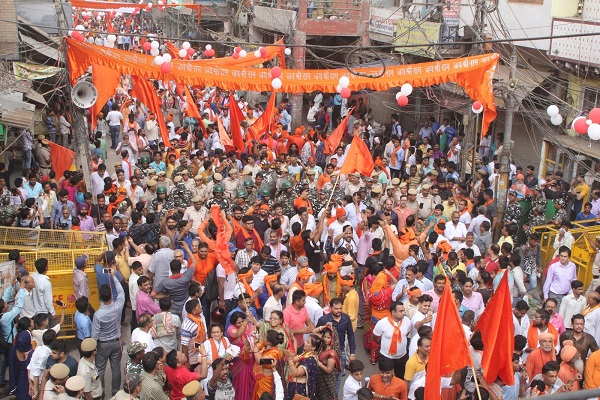New Delhi, As the Ayodhya title suit entered its last phase in the Supreme Court, the Vishwa Hindu Parishad (VHP) expressed confidence that the top court would give a ruling that will pave the way for building of a grand Ram Temple there.
“Considering the facts, the truth, the judgement of the Allahabad High Court and above all, the belief of the whole world, we are sure that the Supreme Court verdict would be in our favour and this would pave the way for building of Ram temple in Ayodhya,” VHP National spokesperson Vinod Bansal told IANS.
His remarks came when asked about expectations of VHP, which has been in the forefront of the Ram mandir movement for decades, as the hearing on title suit issue is slated to conclude on October 17. A judgement on the same is expected by November 17, the date of retirement of Chief Justice of India Ranjan Gogoi.
Hindu Mahasabha lawyer Vishnu Shankar Jain, while commenting on the matter, said, “Our stand on it is very categorical and clear that we don’t need any mediation in the matter.”
He said the case has already seen 38 days of hearing, of which the Hindu side argued for 16 days while on the remaining days the Muslim stand brought its stand before the court. “Now, we hope that the Muslim side concludes its arguments soon, ” Jain said.
When asked about the future course of action, Jain said, “It completely depends on findings of the Hon’ble Supreme Court of India. It’s only after the verdict that we will decide whether we will file a review petition or approach Parliament. But the most crucial thing first is the verdict.”
The Supreme Court had on October 4 said that it would wrap up the hearing in the 70-year-old politically vexing Ram Janmabhoomi-Babri Masjid land dispute at Ayodhya on October 17, a day earlier than its schedule, thus leaving merely four days of active hearing now.
The Hindu parties have consistently argued that the Archaeological Survey of India (ASI) report, which concludes presence of a Hindu temple below the mosque, corroborated by travelogues and Gazetteers of Western visitors identifying the Hindu belief and faith on the birthplace of Lord Ram, weighs high on evidentiary value establishing their arguments.
The Hindu parties have consumed less time, on the arguments claiming its rightful possession on the disputed site, but have maintained sharp and effective response to the queries posed before them by judges on the bench. They avoided being repetitive whereas judges have objected the opposite party for repeating its arguments.
This remaining week will see Muslim parties wrapping up their final submissions before the five-judge bench headed by the Chief Justice and comprising Justices S.A. Bobde, Ashok Bhushan, D.Y. Chandrachud and S.A. Nazeer.
In 2010, the Lucknow bench of the Allahabad High Court, comprising Justice S.U. Khan, Justice Sudhir Agarwal and Justice D.V. Sharma, ruled that there will be an equal division of the disputed land among three parties — one-third for the Sunni Waqf Board, one-third for the Nirmohi Akhara and one-third to the party for ‘Ram Lalla’.
While Justice Khan had then pointed to the unprecedented nature of Hindus and Muslims worshipping together for centuries, Justice Aggarwal had concluded that the inner courtyard of the building belonged to both Hindus and Muslims.
There were two other majority findings, where one judge dissented and two agreed which was that the disputed structure was a mosque and that a temple was demolished to build a mosque.
Justice SU Khan held that no temple was demolished for constructing the mosque at the disputed structure. He said the mosque was constructed under orders of Babar over the ruins of temples lying in that state for a very long time.










